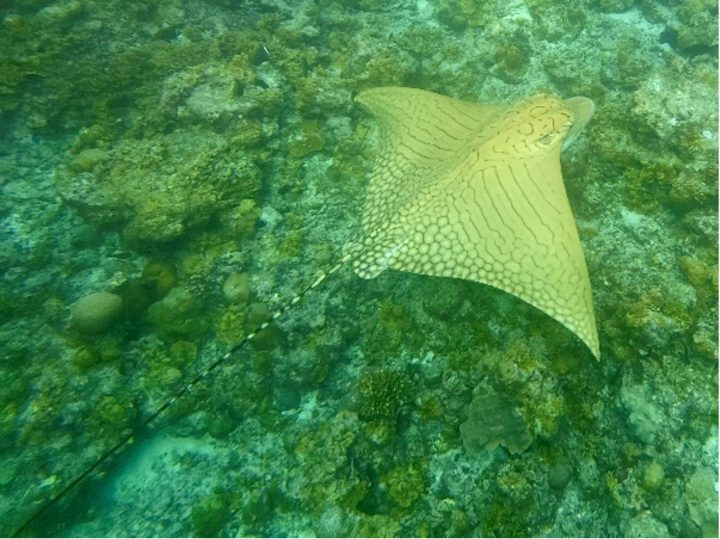

Critically Endangered Eagle Ray Spotted at Maldives Resort
Sunday 3rd of August 2025
A rare sighting of the critically endangered Ornate Eagle Ray took place at OBLU NATURE Helengeli on July 30, when snorkelling guests encountered the elusive species just metres from the island’s house reef. Described by scientists as one of the rarest rays in the ocean, this species has been spotted fewer than 60 times worldwide.
The Ornate Eagle Ray is often referred to as the unicorn of the sea due to its distinctive appearance and extreme rarity. Although its known range stretches from the Indian Ocean to the western Pacific, confirmed sightings remain very limited. Global sources including BBC Wildlife, the Marine Megafauna Foundation and Oceanographic Magazine have all acknowledged its elusive nature. The International Union for Conservation of Nature lists the species as critically endangered, citing a steady decline in population.
The sighting at Helengeli is especially significant because it happened during a casual snorkelling trip, just off the shore. It adds to a very small number of known observations in Maldivian waters.
This is not the only reported encounter of the Ornate Eagle Ray in the Maldives this year. Two earlier sightings took place in January at sister properties in North Male Atoll. A member of staff saw the ray in the main lagoon at OBLU SELECT Sangeli, while a guest captured a photo of one while visiting OBLU XPERIENCE Ailafushi.
All of these observations suggest that reef systems in this region may serve as a refuge for the species, which is increasingly difficult to find elsewhere. While rays have been protected by law in the Maldives since 2014, detailed tracking and monitoring at the species level remains limited.
Marine biologists based at these resorts believe sightings like these offer valuable insight into both the species and the health of local ecosystems. The presence of such a rare animal is seen as a positive sign of reef productivity and recovery, especially in areas where coral restoration projects are ongoing in both shallow and deeper zones.
According to the IUCN, the Ornate Eagle Ray was recorded only three times during a major study of coral reefs that covered 67 countries and territories between 2009 and 2019. Two sightings came from waters off Western Australia, and one from Palau. The ray’s near invisibility in data despite wide-ranging studies raises concern about its future.
Not much is known about the ray’s behaviour or migration patterns, due to the lack of sightings and data. However, the locations of confirmed reports — from the Maldives to Seychelles, Australia and the Philippines — suggest it may travel long distances through tropical reef systems. It is believed to prefer shallow coastal waters with sandy seabeds and healthy coral growth, possibly moving with the seasons for feeding or breeding.
Every new confirmed sighting helps researchers gather more information about this species. Photos from these encounters, particularly those that capture the distinctive back markings of the ray, are shared with marine scientists and contribute to identifying individual animals. These unique patterns allow researchers to track movement and understand distribution over time.
The recent appearances of the Ornate Eagle Ray in North Male Atoll are a reminder of the ocean’s hidden diversity and the value of protecting marine environments. Although the species remains critically endangered, the growing number of sightings in Maldives waters may help support broader conservation work and provide hope for its survival.